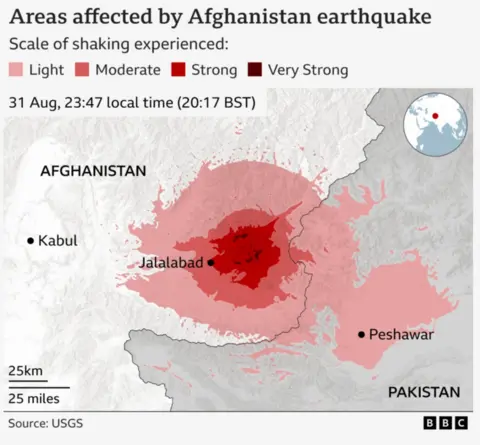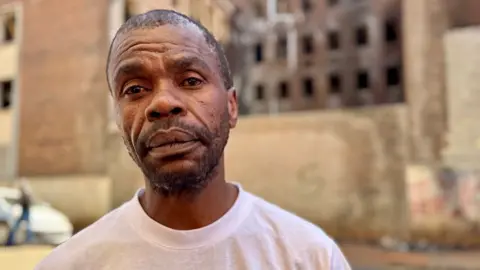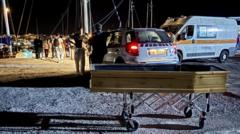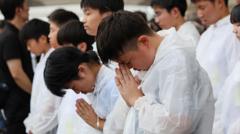Eight decades have passed since British and Canadian forces liberated the Bergen-Belsen concentration camp in northern Germany in April 1945, revealing the devastating extent of Nazi atrocities. The sight that greeted the liberators was one of utter horror: an estimated 13,000 unburied corpses scattered across the camp alongside more than 60,000 emaciated survivors. This year, over a thousand individuals gathered at the site to honor and remember their loved ones and the countless lives lost.
Among the attendees was Mala Tribich, at just 14 when she entered the camp, who now reflects at the age of 94, describing Bergen-Belsen as "a place of skeletons." She recounted witnessing guards dragging the bodies of the dead, leaving a chilling mark on her memory. Esther Alice, another survivor, recalled the heartbreak of losing her mother as they endured the camp's torturous conditions.
While the sun shone on the commemoration, the air remained thick with the memories of suffering. The images of Belsen emerged vividly through first-hand accounts of soldiers, journalists, and witnesses, including a poignant broadcast by the BBC's Richard Dimbleby, who called it the "most horrible" experience of his life. Unlike other concentration camps that were destroyed by the Nazis to conceal their crimes, Bergen-Belsen remained largely intact, maintaining a chilling documentation of its past.
Despite the absence of gas chambers, Belsen was anything but devoid of Nazi cruelty. The camp faced a staggering death toll due to overcrowding, malnutrition, and disease. The final weeks of war saw the deaths of about 30,000 inmates, including notable victims like Anne Frank and her sister. Even after liberation, thousands would fall victim to the lingering effects of deprivation, with the first few weeks of freedom proving fatal for many.
The anniversary event not only served as a remembrance for those who perished but also celebrated the bravery of the survivors. Among the influential figures present were Deputy Prime Minister Angela Rayner and UK Chief Rabbi Sir Ephraim Mirvis, who laid wreaths and offered prayers.
The once-harrowing site has transformed over the years, with efforts made to contain diseases leading to the burning of the camp's barracks, leaving little physical evidence of the past. Yet, a visitors' center and memorial stones remain to honor the dead, signifying a solemn promise to remember the atrocities committed within those walls and the indelible scars they have left on history.
Among the attendees was Mala Tribich, at just 14 when she entered the camp, who now reflects at the age of 94, describing Bergen-Belsen as "a place of skeletons." She recounted witnessing guards dragging the bodies of the dead, leaving a chilling mark on her memory. Esther Alice, another survivor, recalled the heartbreak of losing her mother as they endured the camp's torturous conditions.
While the sun shone on the commemoration, the air remained thick with the memories of suffering. The images of Belsen emerged vividly through first-hand accounts of soldiers, journalists, and witnesses, including a poignant broadcast by the BBC's Richard Dimbleby, who called it the "most horrible" experience of his life. Unlike other concentration camps that were destroyed by the Nazis to conceal their crimes, Bergen-Belsen remained largely intact, maintaining a chilling documentation of its past.
Despite the absence of gas chambers, Belsen was anything but devoid of Nazi cruelty. The camp faced a staggering death toll due to overcrowding, malnutrition, and disease. The final weeks of war saw the deaths of about 30,000 inmates, including notable victims like Anne Frank and her sister. Even after liberation, thousands would fall victim to the lingering effects of deprivation, with the first few weeks of freedom proving fatal for many.
The anniversary event not only served as a remembrance for those who perished but also celebrated the bravery of the survivors. Among the influential figures present were Deputy Prime Minister Angela Rayner and UK Chief Rabbi Sir Ephraim Mirvis, who laid wreaths and offered prayers.
The once-harrowing site has transformed over the years, with efforts made to contain diseases leading to the burning of the camp's barracks, leaving little physical evidence of the past. Yet, a visitors' center and memorial stones remain to honor the dead, signifying a solemn promise to remember the atrocities committed within those walls and the indelible scars they have left on history.




















